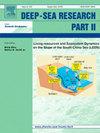Contrasting trends of the ocean CO2 sink and pH in the agulhas current system and the Mozambique basin, south-western Indian ocean (1963–2023)
IF 3
3区 地球科学
Q2 OCEANOGRAPHY
Deep-sea Research Part Ii-topical Studies in Oceanography
Pub Date : 2025-01-17
DOI:10.1016/j.dsr2.2025.105459
引用次数: 0
Abstract
We describe new observations of the oceanic carbonate system in the South-Western Indian Ocean obtained in January 2021 (OISO-31 cruise) and May 2022 (RESILIENCE cruise). To evaluate the decadal trends and drivers of fugacity of CO2 (fCO2), air-sea CO2 fluxes, dissolved inorganic carbon (CT) and pH, we used available data in this region over 1963–2023 and compared the results in the Mozambique Basin and in the Agulhas region near the African coast. Over 1995–2023, we found a faster fCO2 increase in the Mozambique basin (2.03 ± 0.07 μatm.yr−1) compared to the coastal zone (1.37 ± 0.07 μatm.yr−1). The temporal change of anthropogenic CO2 concentrations estimated in subsurface enables to reconstruct the carbonate system properties since the 1960s. In the Mozambique Basin the CO2 sink increased slightly over 1960–2022 with a maximum observed in May 2022 (−2.4 mmolC.m−2.d−1). In the coastal zone, the ocean CO2 sink increased from near equilibrium in the 1960s to a maximum observed in May 2022 (−4.2 mmolC.m−2.d−1). In both regions, we found a decrease of pH, most pronounced in the open ocean zone (−0.020 ± 0.001.decade−1 over 1995–2023). The lowest pH of 8.04 was observed in January 2021, 0.11 lower than in the 1960s. The increase of the CO2 sink and the decrease of pH were mainly driven by anthropogenic CO2 uptake, with about 10% due to the ocean warming.
印度洋西南部阿古拉斯海流系统和莫桑比克海盆海洋CO2汇和pH变化趋势对比(1963-2023)
我们描述了2021年1月(OISO-31巡航)和2022年5月(RESILIENCE巡航)对西南印度洋海洋碳酸盐岩系统的新观测结果。为了评估CO2逸出度(fCO2)、海气CO2通量、溶解无机碳(CT)和pH的年代际趋势和驱动因素,我们使用了该地区1963-2023年的现有数据,并比较了莫桑比克盆地和靠近非洲海岸的Agulhas地区的结果。1995-2023年间,莫桑比克盆地的fCO2增加幅度(2.03±0.07 μatm.yr - 1)高于沿海地区(1.37±0.07 μatm.yr - 1)。通过估算地下人为CO2浓度的时间变化,可以重建20世纪60年代以来碳酸盐体系的性质。在1960-2022年期间,莫桑比克盆地的CO2汇略有增加,在2022年5月观测到最大值(- 2.4 mmol .m−2.d−1)。在海岸带,海洋CO2汇从20世纪60年代的接近平衡增加到2022年5月观测到的最大值(- 4.2 mmolC.m−2.d−1)。在这两个区域,我们发现pH值下降最为明显,在开放海域(1995-2023年- 0.020±0.001. 10 - 1)。2021年1月pH最低,为8.04,比60年代低0.11。CO2汇的增加和pH的降低主要受人为CO2吸收的驱动,其中约10%受海洋变暖的影响。
本文章由计算机程序翻译,如有差异,请以英文原文为准。
求助全文
约1分钟内获得全文
求助全文
来源期刊
CiteScore
6.40
自引率
16.70%
发文量
115
审稿时长
3 months
期刊介绍:
Deep-Sea Research Part II: Topical Studies in Oceanography publishes topical issues from the many international and interdisciplinary projects which are undertaken in oceanography. Besides these special issues from projects, the journal publishes collections of papers presented at conferences. The special issues regularly have electronic annexes of non-text material (numerical data, images, images, video, etc.) which are published with the special issues in ScienceDirect. Deep-Sea Research Part II was split off as a separate journal devoted to topical issues in 1993. Its companion journal Deep-Sea Research Part I: Oceanographic Research Papers, publishes the regular research papers in this area.

 求助内容:
求助内容: 应助结果提醒方式:
应助结果提醒方式:


